Teach a Dog to Heel! in 4 steps
- Anja Boecker
- Updated: 2024-01-09
Teaching your dog to heel is part of every furry friend's basic training. Doesn't it look great to see a four-legged friend walking attentively next to his owner? And that's not all: This command is very useful in all kinds of situations.
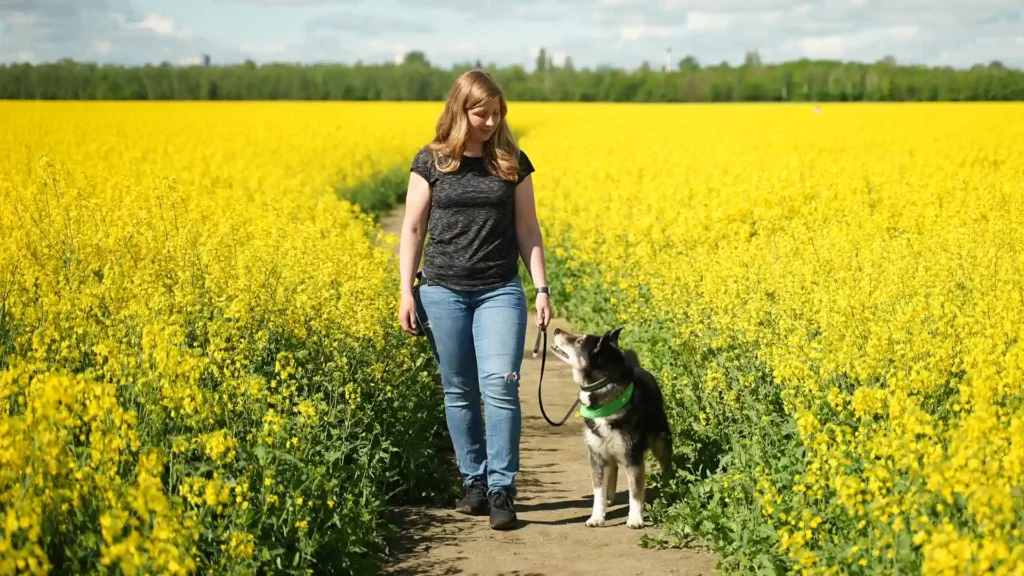
Meaning of "Heel"
"Heel" means your dog is walking right beside you, with his shoulder at about knee level. He should be relaxed but alert to your movements and cues. In heel mode, your dog stays close to you without pulling or hesitating. He pays attention to you and responds to your changes in direction and pace.
Why Is the Heel Command So Important?
Every dog should learn to heel at an early age. But what's the point? This question is easy to answer: there will always be situations where you need your pet to be by your side.
Be it in the pedestrian zone in the city center, on a narrow sidewalk on the street or on a dirt road where you meet another person with a dog.
This command is the critical bridge to safety in these moments. Your dog will walk close to you and concentrate on you. This way, he won't interfere with other people trying to pass by, and he'll be better protected if someone bumps into him.
Focusing on you alone will also help ensure that your dog does not want to greet another person or dog without permission. Once this command is ingrained in your dog's mind, you will be much more relaxed in everyday life.
- Safety: The "heel" command is critical to the safety of your dog and your surroundings. It prevents your dog from getting into dangerous situations, such as running into the road or other animals.
- Control and management: "Heel" allows you to lead your dog in a controlled manner, which is especially important in busy or unfamiliar environments.
- Building trust: A dog that has learned to heel shows trust and respect to its owner. This strengthens the bond and mutual understanding.
- Relaxed walks: With a reliable "heel walk", walks will be more relaxed and enjoyable for you and your dog. You can focus on your surroundings and your time together instead of getting into constant conflict.
- Dense crowd: On busy streets or at events, "Heel" ensures that your dog does not disturb or endanger anyone.
- Road traffic: At roadsides or crosswalks, a reliable "heel" is essential to prevent your dog from suddenly running into the street.
- Vet visits and public transportation: Places where calm and discipline are needed often require a "heel" to avoid stress and chaos.
- Encounters with other animals: When encountering other dogs or animals, "heel" helps to avoid conflict and unwanted interactions.
Preparing for Training
Before you begin training your dog to heel, careful preparation is essential for success. The right equipment and a positive training environment are key to teaching your dog this important command.
Choosing the Right Equipment
Choose a suitable leash that is long enough to allow your dog some freedom of movement, but short enough to keep him under control. A standard leash of about 1.5 to 2 meters is often ideal. A well-fitting harness is a gentle and safe solution, especially for dogs that tend to pull. It distributes pressure evenly and avoids pressure on the neck. If you prefer a collar, make sure it fits comfortably and gives your dog enough freedom of movement without slipping or pinching.
Create a Positive Training Environment
Start in a quiet environment without distractions, such as your backyard or a quiet park. This will allow your dog to focus on the training. Create a training schedule with regular training times to develop a routine. Short, frequent training sessions are more effective than long, tiring sessions. Your attitude during training is very important. Be patient, encouraging, and positive to create an atmosphere conducive to learning. Provide motivational rewards such as favorite treats or toys. Reward your dog for small successes to motivate him to continue learning.
Preparing Your Dog
Make sure your dog is healthy and fit for training. A well-rested but not overtired dog is ideal. Be aware of your dog's mood. He should be alert and interested, but not overexcited or anxious.
4 Steps to a Safe "Heel”
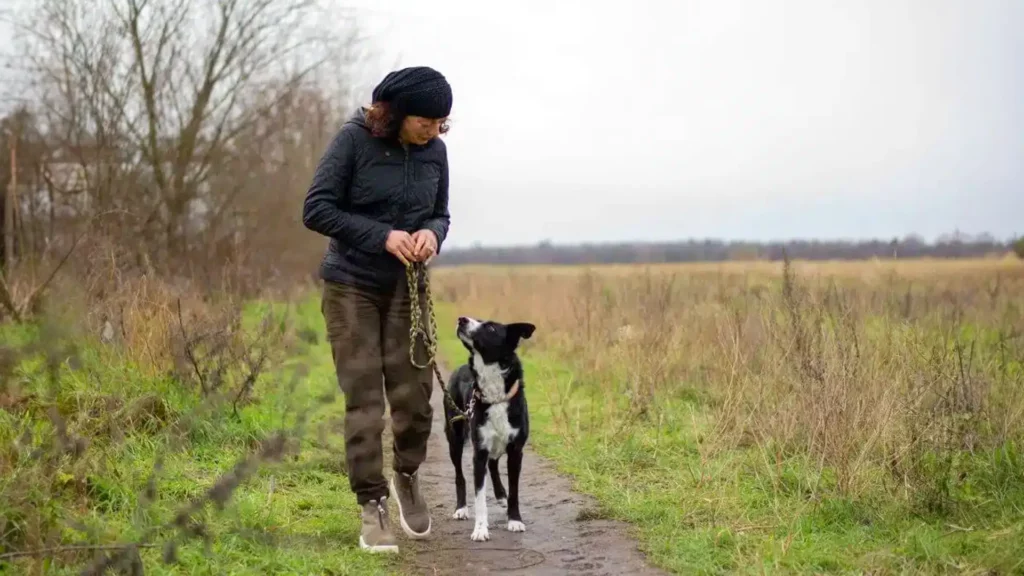
It is important to train in a low-stimulus environment in the beginning. This way there are fewer distractions for your dog and he can focus more on you and your training. Your home is the best place to do this. Also, make sure you train in short sessions. If the training sessions are too long, your furry friend will lose concentration and you won't be successful.
Step No. 1
First decide whether you want your dog to run to your right or left when you give this command. Hold a treat in your hand on the side you want your dog to go. If you're practicing indoors first, you don't need a leash. Outside, however, it is advisable to use a leash. Get your dog's attention by talking to him and showing him the treat.
Reward your dog when he looks at you. Especially if he does so without you talking to him. The reward can be a mix of treats, verbal praise, and petting. But don't get too hectic and excited - we don't want him jumping on you out of excitement!
Step No. 2
When your dog is sitting or standing on the side you want, give the "heel" signal and take 2 to 3 steps forward. The signal can be a tap on the side of your thigh or a word such as "heel" or "come with me. A few steps are enough to get started.
Your dog will follow you by concentrating on the treat in your hand. This will automatically keep him at the correct distance. Stop again and give your dog the treat when he has done it correctly. Provide additional verbal praise.
Make sure your dog does not jump on you to get the treat. If this happens, stop and wait for your dog to calm down next to you. Then repeat the exercise. Perform this short step successfully several times - preferably in several training sessions - before moving on to the next step.
Also, make sure you always end the command with a termination signal such as "Done" or "Okay. This way, your dog knows when he's done with the exercise and doesn't decide for himself when it's over.
Step No. 3
Increase the demands slowly. Start by simply increasing the distance you want your pet to walk. Raise your hand with the treat a little higher. Be sure to do this in short intervals and repeat each exercise several times with success before increasing the distance further.
It is also a good idea to include running around curves and obstacles in your training. This will make it easier for you in everyday situations later on, since you probably won't just be running straight ahead on the open road. You should also vary your pace: Sometimes you should crawl slowly, sometimes you should walk normally, and sometimes you should jog.
You can also hold the treat in your hand less conspicuously, so your dog learns to focus on you and not just on his coveted reward. You are the key to the prize! At this stage, you can also begin to introduce distractions. Have a friend walk by or place your dog's favorite toy in a prominent place near you.
Your dog should continue to walk beside you and focus on you instead of paying attention to the attraction and perhaps even running toward it. You should also practice these situations successfully several times in a row before making the training more difficult again. Regular breaks are just as important for success as successful repetition.
Step No. 4
If the previous steps work well, you can take the training outside and gradually incorporate moments that you might encounter in everyday life. For example, you can have your dog heel while another dog walks by. Or you can walk past a playground with lots of children playing.
You are the best judge of how well your dog has mastered this command. If you feel confident that your dog can do this, you may want to take him for a walk around the town square using the heel command. However, this is very difficult for your dog because there are exciting distractions everywhere.
So it takes a lot of training and patience before your furry friend can do this. Don't be upset if something goes wrong. Just practice again in a less exciting situation. Over time, you can reward less and less with treats. Once your dog has internalized the command, verbal praise will suffice.
Is this too theoretical for you? If you prefer a visual approach, our app offers step-by-step video instructions to help you teach your dog to heel. Learn more about our app here.
Remember:
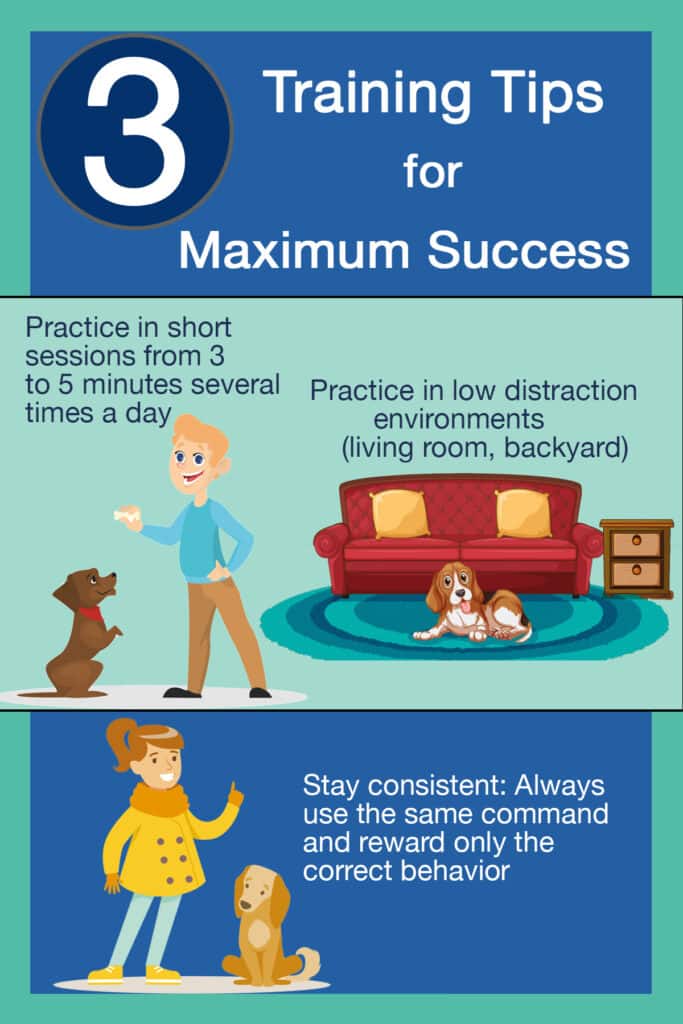
6 Common Challenges & Their Solutions
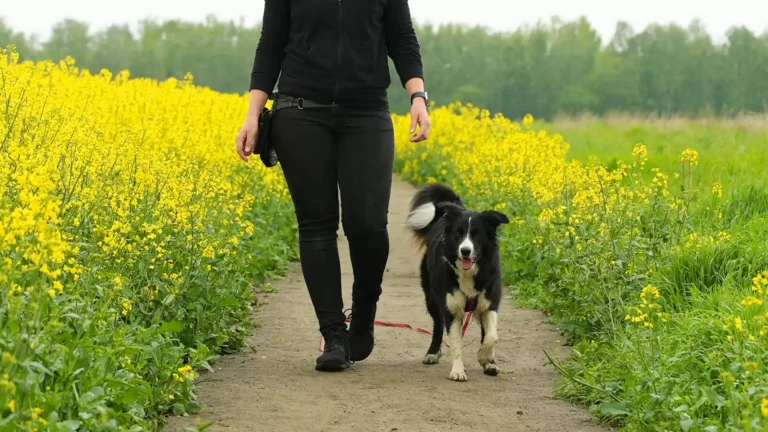
Heel training can sometimes be frustrating, both for your dog and for you as an owner. Here are some of the most common problems that can occur during training, and practical solutions for effectively overcoming them.
1. Your Dog Is Constantly Pulling On the Leash.
- Problem: Your dog is pulling forward and not responding to the "heel" command.
- Solution: Stop when your dog begins to pull. Only move forward when the leash is slack. This will teach him that pulling does not lead to the goal.
2. Your Dog Is Easily Distracted
- Problem: Your dog is distracted by smells, noises or other animals and cannot concentrate on "heel".
- Solution: Begin training in a quiet environment with few distractions. Gradually introduce more distractions as the dog becomes more reliable.
3. Your Dog Does Not Understand the Command
- Problem: Your dog seems confused and doesn't understand what is expected of him.
- Solution: Go back to basics. Shorten training sessions and focus on the first steps. Use clear and consistent cues.
4. Your Dog Gets Tired or Frustrated Easily
- Problem: Your dog shows signs of fatigue or frustration and loses interest in training.
- Solution: Keep training sessions short and positive. Take breaks before your dog becomes overwhelmed and end the training on a positive note.
5. Your Dog Only Responds When a Reward Is Visible
- Problem: Your dog will only heel if he knows there is a reward.
- Solution: Make the reward unpredictable. Don't reward every correct execution, but vary when and how you reward.
6. Your Dog Loses Interest Over Time
- Problem: Your dog can "heel" for short periods of time, but loses interest over longer distances.
- Solution: Build up the training slowly. Gradually increase the amount of time your dog has to "heel" and reward him especially for staying longer.
By understanding and proactively addressing these challenges, you can increase the effectiveness of your heel training. Every dog is unique, and some may require more specific adjustments or patience. Remember, the goal is a harmonious and safe relationship with your dog, based on understanding and respect.
Teaching Puppies to Heel
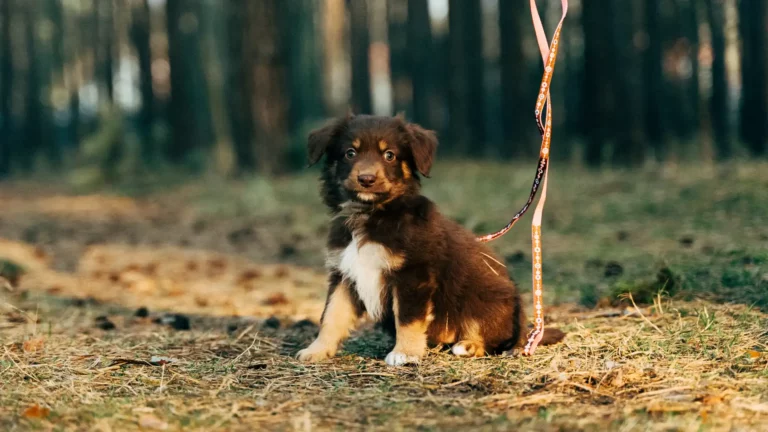
The heel command is a valuable tool for teaching your puppy to walk calmly and attentively at your side. More than just an obedience exercise, it's a way to strengthen your bond with your puppy and lay the foundation for safe and enjoyable walks. Here's how to get started:
1. Lay the Foundation
Start with short sessions: Puppies have short attention spans, so keep training sessions short (5-10 minutes) and fun. Positive environment: Start in a quiet environment with no distractions so your puppy can focus on you.
2. Introduction to the Commands
Leash and Harness: Get your puppy used to the leash and harness. Let him sniff the equipment and become familiar with it. Introduce the command: Begin by standing or sitting next to your puppy and saying the command "heel" followed by his name. You can tap your side to get his attention.
3. First Steps
Encourage him to follow you: Take a few steps and lure your puppy beside you with a treat or toy. When he follows, praise him enthusiastically and give him the reward. Short Distances: Start with a few steps and gradually increase the distance as your puppy learns the concept.
4. Consistency and Patience
Repetition and routine: Practice daily, but don't overwhelm your puppy. Short, regular training sessions are more effective than long, tiring ones. Be patient: Not every day is perfect. Be patient and understanding - learning is a process.
5. Positive Reinforcement
Use rewards: Reward your puppy immediately when he walks correctly by your side. Use praise, treats, or his favorite toy as a reward. Build a strong bond: Use training to build a positive relationship with your puppy. Laughter and fun are important.
6. Overcoming Challenges
Provide distractions: Once your puppy can "heel" in a quiet environment, introduce mild distractions such as household noises or a quiet park. Continue to adapt: Adapt training to your puppy's progress and personality. Each puppy is unique and learns at his own pace.
Teaching your puppy to heel at an early age will lay the foundation for a lifetime of safe and enjoyable walks. Remember, it's not just about learning obedience, it's about exploring the world together safely and happily.
Take Care of Your Dog
Make sure leashes and harnesses fit snugly and show no signs of wear to prevent accidents. If you use a collar, make sure it is not too tight and is comfortable for your dog.
Be aware of physical limitations and consider your dog's age, health, and physical condition. Older dogs or dogs with health restrictions may require shorter and gentler training sessions. Watch for signs of fatigue or overexertion and stop training before your dog becomes exhausted or stressed.
Choose safe and quiet places for training to minimize distractions and dangers. Always be aware of your surroundings and avoid situations that could endanger your dog or others.
Use positive reinforcement to avoid stress and promote positive learning experiences. Be patient and understanding. Every dog learns at his own pace, and pressure or punishment can be counterproductive.
Build regular breaks into the training so that your dog can recover.
Always provide fresh water, especially on hot days. After each workout, check your dog's paws, coat, and general condition to make sure he has not suffered any injuries or discomfort. Give your dog plenty of time to rest and recover after exercise.
Using Positive Reinforcement Correctly
Positive reinforcement is an effective and animal-friendly way to teach your dog to heel. It is based on the principle of rewarding desired behavior to encourage it. Learn how and why to use positive reinforcement and get tips for effective rewards.
Positive reinforcement makes training more interesting and rewarding for your dog. A motivated dog is more likely to learn and cooperate. This method promotes a trusting and respectful relationship between you and your dog, which is essential for heel training.
Reward your dog immediately when he "heels" correctly. This helps him understand that his behavior triggers the reward. Be consistent with your commands and rewards. Your dog should know exactly what is expected of him and when he will receive a reward.
Choose rewards that your dog really enjoys. These can be favorite treats, praise, or playtime. The reward should be appropriate for the behavior. Alternate the types of rewards to keep your dog interested and avoid dependence on one type of reward.
Begin by slowly reducing the frequency of the rewards once your dog reliably "heels. Replace them with verbal praise or petting for a lasting change in behavior.
Tips for Effective Rewards
- Time is of the essence: Reward your dog immediately after the desired behavior to create the best connection.
- Be predictable: Your dog should know that good behavior will always be rewarded. Unpredictability can lead to confusion and frustration.
- Stay positive: Even if progress is slow, remain positive and patient. Your attitude affects the learning environment and your learning success.
By using positive reinforcement correctly, you can teach your dog to heel in a way that is enjoyable and rewarding for both you and your dog. Remember that each animal is unique and will learn and adapt at its own pace. Celebrate small successes and enjoy your training time together!
Frequently Asked Questions
This command is used to make your dog walk next to you on command. This is useful in many everyday situations, such as when you need to walk through a crowd or when you want your dog to walk next to you while you pass another dog.
Your dog never does anything wrong on purpose! He just doesn't understand what's expected of him yet, or he's not very good at resisting interesting distractions. But it's not his fault - it's his nature to want to sniff and discover! That's why patience, lots of repetition, small increments and, of course, praise and rewards are the ingredients for lasting training success.
It is important to practice in small increments. Start in an environment with few exciting distractions. Over time, you can increase the level of difficulty. See our article for detailed instructions.
You can start teaching your puppy to heel as soon as he understands basic commands such as sit and has developed some attention span, which is usually between 8 and 10 weeks of age. It's important to keep training short, positive, and playful to keep your puppy focused and interested.
Conclusion
The "heel" command is a valuable skill that will benefit both of you in everyday life. It provides an opportunity to explore the world together without stress and with the knowledge that your dog is safe and alert at your side.
With each step you take together, you strengthen your bond and your understanding of each other. It's a long but rewarding journey that will foster a deeper and more trusting relationship between you and your dog.
With these tips, it's guaranteed to work:
- Practice in small steps
- Always reward immediately after a successful exercise - this is the only way your dog will associate the praise with walking beside you!
- Be patient! No master has ever fallen from the sky, not even among the fur noses.
Share Now:

My name is Anja Boecker, and I am a certified dog trainer and behavior consultant. With these articles, I want to help you to understand your dog better and to build an inseparable bond.

